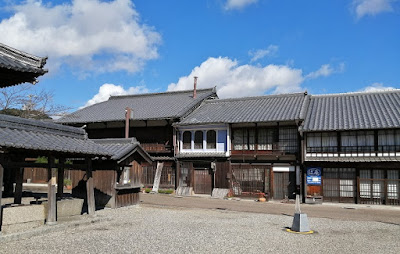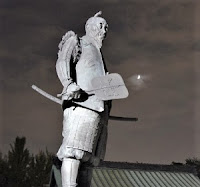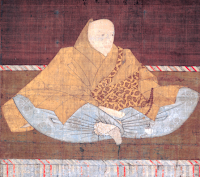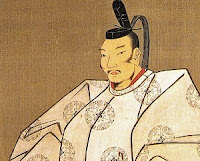Who are them?
(renewed on January 05/2023)Now, No.01 - No.44 are there.
We have been uploading 80 and more articles. And we decide to summarize brief descriptions of people and groups who we described in each article. Japanese people have overloaded information about historical people and groups in their mind. Because, we can think of right now, they are fond of NHK historical drama 'Taiga drama'. And so much information relevant to life lessons is mentioned in connection to historical people's attitude in the media. They probably understand who is a certain historical character such as achievements, personality, and the time he lived.
We recently noticed that we had described only historical people's and group's name without explanation of their background. So, in this article, we will describe additional information about characters who appeared in our previous articles. Maybe many readers will think this attempt isn't necessary, because they already know such kind of Japanese historical information. And we have one more concern that it needs long time to complete. However, we decide to try.
❓ Descriptions are listed according to their appearance.
(P) means the person, and (G) means the group.
Names are written both English characters and Japanese characters.
(01)(02)... mean articles in which these characters appeared.
Additional descriptions are 1. their dates, 2. overview.
No.01 (G) The Tokugawa family / 徳川家 (01)(02)(12)(15)(21)
(1) 1566 - to date
(2) One of Japanese history's most famous families. This family was established by Tokugawa Ieyasu (he changed his family name) and exists still now. The Edo shogunate which was also established by Tokugawa Ieyasu and survined 250 and more years until the generation of 15th Shogun (Tokugawa Yoshinobu). (1603 - 1867) Before the Tokugawa family's ruling all over Japan, it was governed by the Toyotomi family.
No.02 (G) The Toyotomi family / 豊臣家 (01)(02)(03)(13)(21)
(1) 1586 - 1615
(2) One of Japanese history's most famous families. The family name 'Toyotomi' was a special name which Toyotomi Hideyoshi was granted from an emperor. (1586) The Toyotomi family was beaten by the Tokugawa family and was destroyed in the Siege of Osaka. (1615) Toyotomi Hideyoshi became the ruler of Japan after the death of Oda Nobunaga (he was killed by one of his retainers). (1582) After this incident, Toyotomi Hideyoshi battled with several powerful Sengoku Daimyos and won the battles. (around 1584)
No.03 (P) Sen-hime / 千姫 (01)
(1) 1597 - 1666
(2) Eldest daughter of the second shogun, Tokugawa Hidetada. Famous point in Japanese history is her marrige with Toyotomi Hideyori who was the son of Toyotomi Hideyoshi. (1603) When Hideyori marriaged with Sen-hime, the Toyotomi family ruled Japan, so she became the wife of the ruler. 12 years after the marriage, the Tokugawa family and the Toyotomi family fought each other, and the Toyotomi family was destroyed. The incident called 'The Osaka-no-jin' war. (1615) She was rescued from the battle field and remarried with one of Tokugawa's vassals. Her remarried partner was the lord of the HImeji castle. Nishino-maru 'Kesho' tower in the Himeji castle was made when their marriage held, so, she was linked with the Himeji castle by fate.
No.04 (G) Ii clan (family) / 井伊家 (02)
(1) around 1275 - to date
(2) One of the powerful clans (families) incorporated into the Tokugawa clan. This clan was incorporated into Tokugawa in 1575, after that, it distinguished itself in many battle fields. It also ordered to build the Hikone castle and completed it. In the Edo shogunate, this family was registered as one of leading vassals and was appointed an important position. Whereas other vassals were ordered to relocate their dominant territories, the Ii clan had been a dominator of the Hikone district.
No.05 (P) Oda Nobunaga / 織田信長 (03)(11)(12)(15)(17)(18)(27)(28)
(1) 1534 - 1582
(2) He was a rural lord on the part of Aichi prefecture, and later, extended his influence widely. In his peak period, he governed Kyoto and throughout the Kinki region which was considered as the center of Japan. So, he was regarded as the first ruler of whole Japan at the end of the Sengoku period. He thought out a tactic of using mass muskets, so, it is said that he was an innovator and a person who destroyed long standing abuses.
No.06 (P) Ashikaga Yoshiaki / 足利義昭 (03)(11)
(1) 1537 - 1597
(2) The 15th shogun of the Muromachi shogunate (1336 -1573) and the last shogun of it. The period when the Muromachi shogunate governed is called the Muromachi period, and as of the latter half, the Sengoku period is used generally. He became the 15th shogun by the help of the military power of Oda Nobunaga, but later, they dispute each other. As the result of the conflict, he was expelled from Kyoto, and the Muromachi shogunate was destroyed. After the downfall of the shogunate, however, he survived and became the retainer of Toyotomi Hideyoshi, the next ruler.
No.07 (P) Takeda Katsuyori / 武田勝頼 (03)
(1)1546 - 1582
(2)Takeda Katsuyori was the inheritor of Takeda Shingen, one of the great commanders in the Sengoku period. He inherited his father's vast territories which lay on Yamanashi Pref., Nagano Pref. and Shizuoka Pref. After that, he lost the battle of Nagashino (1575) and later, was destroyed by Oda Nobunaga. Because of this historical result, he tends to be drawn as an incompetent commander compared with his father.
No.08 (P) Takeda Shingen / 武田信玄 (03)
(1)1521 - 1573
(2)One of the most powerful Sengoku Daimyo. At his heyday, he governed vast territories which lay on Yamanashi Pref., Nagano Pref. and Shizuoka Pref.
No.09 (P) Toyotomi Hideyoshi / 豊臣秀吉
(Hashiba Hideyoshi / 羽柴秀吉) (03)(11)(12)(15)(18)
(1) 1537 - 1598
(2) At first, Toyotomi Hideyoshi was a retainer of Oda Nobunaga. After the death of Oda Nobunaga, he struggled many other powerful Daimyo and beated down them. He widened his territories all around Japan and became the ruler of Japan. He attacked Korea in his later years. When he died, Tokugawa Ieyasu challenged the Toyotomi family and became the next ruler. The Toyotomi family was destroyed at the date of Hideyosi's son.
No.10 (P) Ii Naosuke / 井伊直弼 (04)
(1) 1815 - 1860
(2) He was one of Daimyo who played active roles in the administrative organization of the Edo shogunate at the latter half of the Edo period. He became the responsible person of a conclusion of a treaty between Japan and US. He bulled through the conclusion and cracked down on the opponents. This oppression triggered his death by an assassin.
No.11 (P) Tokugawa Ieyasu / 徳川家康 (05)(06)(11)(12)(18)(19)(24)
(1) 1543 - 1616
(2) Tokugawa Ieyasu destroyed the Toyotomi family and became the next ruler. He founded the Edo shogunate. Oda Nobunaga, Toyotomi Hideyoshi and Tokugawa Ieyasu are called the 3 heroes and they were the greatest men during the Sengoku period.
No.12 (P) Honda Tadakatsu / 本多忠勝 (05)
(1) 1548 - 1610
(2) One of the brave vassals of Tokugawa Ieyasu. He obeyed Tokugawa Ieyasu from an early stage and played many active roles in the Tokugawa army. There are many legendary episodes, so, people tend to treat him as a god of military arts. Sen-hime's remarried partner was a grandson of him.
No.13 (P) Emperor Godaigo / 後醍醐天皇 (09)(10)
(1) 1288 - 1339
(2) Emperor Godaigo conflicted with the Kamakura shogunate and was exiled. (1332) And the next year, he and his allies overthrew the shogunate and established a new administration. (1333) One of his powerful allies, Ashikaga Takauji rebelled and established the Muromachi shogunate. (1338) He escaped from Kyoto and established an exiled regime, but he died the following year. (1339) The exiled regime continued several years and faded away. (1392)
No.14 (P) Ashikaga Takauji / 足利尊氏 (09)
(1) 1305 - 1358
(2) Ashikaga Takauji was one of important vassals in the Kamakura shogunate, he was dispatched to Kyoto for repressing of Emperor Godaigo's rebellion. He switched to the opposite side, and that incident caused the collapse of the Kamakura shogunate. (1333) He joined the new administration as an important figure, however, he soon conflicted with Emperor Godaigo, and made the Muromachi shogunate.(1338) Death of the opponent made their power was decreased, conversely, his shogunate continued to rule of Japan. A civil war because of the conflict of powerful people in the same group continued in his lifetime.
No.15 (P) Musou Soseki / 夢窓疎石 (09)
(1) 1275 - 1351
(2) A high priest of Zen Buddhism, acquainted with both Emperor Godaigo and Ashikaga Takauji. Poriticians took his suggestion into consideration, because they devoted themselves to Zen Buddhism deeply. The establishment of the Tenryu-ji temple was decided by his suggestion. He was also a famous garden planner at that time, and he planned many famous gardens such as the Tenryu-ji temple's garden.
No.16 (P) Hanazono Joko / 花園上皇 (10)(15)
(1) 1297 - 1348
(2) He was the former Emperor of Godaigo. 'Joko' or the Emperor Emeritus is who abdicate the Emperor. He was called Hanazono Joko after his abdication and until his becoming-a-priest. (1318 - 1335) During the Emperor Godaigo's time, he didn't relate to politics because Emperor Godaigo decided by himself. When he became a priest, he renovated his residence into a temple, and that was the Myoshin-ji temple.
No.17 (P) Ashikaga Yoshimitsu / 足利義満 (10)
(1) 1358 - 1408
(2) Ashikaga Yoshimitsu was the third shogun of the Muromachi shogunate. In his ruling time, the administration had been getting strong. And in the latter half, the Muromachi period was flourished best. After he abdicated the Shogun's position to his son, he built a palace in Kitayama district and constructed the Kinkaku-ji temple there.
No.18 (G) Kouga Mochizuki family / (甲賀)望月家 (11)
(1) ?
(2) The Mchizuki family who lived in Kouga region is written as the Kouga Mochizuki family to distinguish from other Mochizuki families. It is said that the Kouga-ryu Ninjutsu-yashiki (甲賀流忍術屋敷) was the residence of the Kouga Mochizuki family. (the basis is doubtful) According to one theory, this residence was owned by the Mochizuki family who was a mountain priest but the descendant of the Mochizuki clan who had played an active role at a battle against the Muromachi shogun.
No.19 (G) Rokkaku clan (family) / 六角家 (11)
(1) ? - 1574 ?
(2) The Rokkaku clan was the Shugo or the regional president of Omi district during the Muromachi period. (1336 - 1573) This family was attacked by Oda Nobunaga's army and was defeated. And also they lost their castles. (1568) They tried to make a comeback but failed. At the very end of the Sengoku period, they lost the status as Daimyo. Around the beginning of the Edo period (1603 - 1868), their descendants became retainers of other Daimyo.
No.20 (P) Wada (Koremasa) / 和田(惟政) (11)
(1) ? - 1571
(2) He was one of the rural lords of Kouga district. He helped Ashikaga Yoshiaki and became one of his vassals. When Ashikaga Yoshiaki became a shogun with Oda Nobunaga's military power as background, he also became an important vassal of Oda Nobunaga. He was killed at the battle occurred at Ibaragi city, Osaka Pref.. (1571)
No.21 (P) Todo Takatora / 藤堂高虎 (12)
(1) 1556 - 1630
(2) Todo Takatora was a Daimyo who was good at fortification and planned many castles. He also participated in many battles and distinguished himself many times. During the Toyotomi Hideyoshi ruling era, he became the lord of the Uwajima castle. (1596) And after the death of the ruler, he reconstructed the Iga-ueno castle belonging to Tokugawa Ieyasu side. When Tokugawa era came, he became the lord of the Iga-ueno castle and the Tsu castle. (1608) During the Edo period, his family and descendants were given important positions by the authority.
No.22 (G) Asyura / 阿修羅 (12)
(1) 1987 - to date
(2) They are the performance group who perform a Ninja show at the Iga-ryu Ninja Museum.
No.23 (G) Todo clan (family) / 藤堂家 (12)
(1) ? - to date
(2) The Todo clan was a local clan of Omi region. And they were no longer samurai before Todo Takatora seizing the opportunity. They received important positions throughout the Edo period. When the Meiji period came, they also received high status as an ex-Daimyo.
No.24 (G) Sawamura family / 澤村家 (12)
(1) ?
(2) The Sawamura family was a local clan of Iga region. And they served the Todo clan as a Ninja. There was a story one of this family snuck into an American battle ship at the end of the Edo period. This family still lives in the Sawamura family mansion.
No.25 (G) takesima family / 竹島家 (12)
(1) ?
(2) The Takeshima family seems to have been a local clan of Iga region. (no detailed information) It is said that they participated in the battle against Oda Nobunaga in the Sengoku period. They don't live in the Takeshima family mansion now.
No.26 (P) certain Kawai / 河合 某 (河合又五郎) (13)
(1) 1615 - 1634
(2) He was a retainer of the Okayama-han lord (Ikeda clan). He killed a co-worker who was a favorite of the lord. (1630) As a result, he was labeled as the target of the revenge killing. He escaped from his home town, and he moved to Edo and later Nara. Then, he intended moving again from Nara to Edo. On the way to Edo he and his supporters were attacked and killed at the Kagiya-no-tsuji, Iga city.
No.27 (P) certain Watanabe / 渡辺 某 (渡辺源太夫) (13)
(1) ? - 1630
(2) He was a retainer of the Okayama-han lord (Ikeda clan). The beginning of the duel at Kagiya-no-tsuji was his death.
No.28 (P) elder brother of Watanabe / 渡辺の兄 (渡辺数馬) (13)
(1) ?
(2) He was a retainer of the Okayama-han lord (Ikeda clan). His elderly sister's husband helped this Adauchi. He completed the task, so, after the incident, he belonged the Ikeda clan again.
No.29 (P) Matsuo Basho / 松尾芭蕉 (13)
(1) 1644 - 1694
(2) He was a famous poet in the Edo period. His expertise was Haikai (one of Japanese poems). Later, his poems became to be called Haiku (also one of Japanese poem). He is a leading figure of Haiku poem.
No.30 (P) Masaoka Shiki / 正岡子規 (13)
(1) 1867 - 1902

(2) He was a famous poet good at Haiku and Waka. He was a journalist at first and became a poet later.
No.31 (G) Hakakeyama clan (family) / 畠山家 (15)
(1) 1200? - 1566
(2) The Hatakeyama clan was the Shugo or the regional president of Noto district during the Muromachi period. (1336 - 1573) During the Sengoku period, the Muromachi shogunate began to decline, and also this family followed it. They lost momentum and their retainers took place. There were several Hatakeyama families governed several districts. The Hatakeyama family in Noto district was taken over by a vassal in the latter part of the Sengoku period. (1566)
No.32 (G) Otomo clan (family) / 大友家 (15)
(1) 1172? - 1600?
(2) In the old days of the Kamakura period (1185 - 1333), the Otomo family expanded their controlled areas in the Kyushu region. Their headquarters was around Oita prefecture nowadays. Their territory changed rapidly, sometimes expanded enormously sometimes shrunk. This family was a Shugo during the Muromachi period (1336 - 1573), and was a Daimyo during the Sengoku period. In the latter part of the Sengoku period, it was beaten by neighboring Daimyos several time and hanged on Toyotomi Hideyoshi's sleeves. After twists and turns, the Otomo clan as a Daimyo perished before the beginning of the Edo period.
No.33 (G) Maeda clan (family) / 前田家 (15)(22)(23)
(1) 1539 - to date
(2) The Maeda family was a small local clan, became a vassal of Oda Nobunaga, got promoted, became a Daimyo in Noto district. After the death of Oda Nobunaga, it became a vassal of Toyotomi Hideyoshi, expanded their dominate territory. And then it became a vassal of Tokugawa Ieyasu. Through the Edo period, it became the Daimyo governed the largest territory. When the Meiji period came, it gained aristocratic status, became a noble and super-rich family. During WW2, the head of this family was the commander at the Boruneo Island, and killed there.
No.34 (P) Shuho Myocho / 宗峰妙超 (15)
(1) 1283 - 1338
(2) The chief priest when the Daitoku-ji temple established. Emperor Hanazono became a believer of Shuho Myocho.
No.35 (G) Oda clan (family) / 織田家 (16)
(1)1402 ? - 1605
(2)The Oda clan was the Owari Shugo-dai or the deputy of regional president of Owari district. (1402~) Speaking of their status before 1402, there aren't exact records, however, they were a vassal of the Hashiba clan who was the Shugo of Owari district. Oda Nobunaga (1534 - 1582) expanded the Oda clan's sphere of influence, however, he was killed by one of his followers. After that incident, Toyotomi Hideyoshi became the successor of the position and governed whole Japan several years. The Oda clan tumbled out of the position of the ruler, and was survived as a Daimyo. However, at the beginning of the Edo period, they became extinct. (1605)
No.36 (P) Toyotomi Hidetsugu / 豊臣秀次 (16)
(1)1568 - 1595
(2)He was a son of Toyotomi Hideyoshi's elder sister, so, he was a nephew of Toyotomi Hideyoshi. During his younger days, he spent hard time as a hostage of Toyotomi Hideyoshi several times. Side-by-side with his uncle's promotion, he also promoted. He became the Daimyo of Omi (430,000 koku) in 1585, and the Daimyo of Owari-Ise (1,000,000 koku) in 1590. ("koku" is the unit of weight of rice. 1 koku = 150 kilograms) He was regarded as the successor of Toyotomi Hideyoshi, however, he was ordered to suicide by hara-kiri and died. (1595) When he became the lord of the Inuyama castle, he also became the lord of the Kiyosu castle, so, his father (his deputy) became the virtual lord of the Inuyama castle.
No.37 (P) Ishikawa Sadakiyo / 石川貞清 (16)
(1) ? - 1626
(2) Ishikawa Sadakiyo became the load of the Inuyama castle after Toyotomi Hidetsugu was removed fromthe position. (1595) He renovated the castle in 1599. At the time of Sekigahara war (1600), his group was defeated. He quitted samurai and became a merchant. And lived in Tyoto the latter half of his life.
No.38 (P) Akechi Mitsuhide / 明智光秀 (17)
(2) Akechi Mitsuhide was one of Oda Nobunaga's main followers. He killed Oda Nobunaga and became Nobunaga's next ruler. (1582) But soon after the incident, his army battled against Toyotomi Hideyoshi's army and was defeated. And, after the battle, he was killed by somebody we don't know who they were. (1582) He captured the Fukuchiyama castle in 1578 and renovated it the next year. The Fukuchiyama castle was the center of the rural government for a long time.
No.39 (G) Mouri clan (family) / 毛利家 (18)
(1) 1340? - to date
(2) The Mouri clan immigrated to Hiroshima Pref. around 1340. Famous Mouri Motonari was very active and he spread his territory to whole Sanyo region and Sanin region. Then the Mouri clan became a big Daimyo. And also they became to control pirates in the Seto Inland Sea, and made the Mouri navy. Speaking of the navy in the Sengoku period, the Mouri navy comes out first. Afterwards they still survived as the Daimyo while reducing its controlled area. And they became noblemen in Meiji period, and still continue.
No.40 (P) Imagawa Yoshimoto / 今川義元 (19)
(1) 1519 - 1560(2) Imagawa Yoshimoto was born as a son of the head of the Imagawa clan. Because of the death of his elder brothers, he became the successor of the clan. He fought against the Takeda clan (Northern boundary) and the Hojyo clan (Eastern boundary), and he expanded his territory. He also made the Matsudaira clan into his retainers. And he attacked the Oda clan who was the lord west of the Matsudaira clan, but was defeated and killed. (1560)
No.41 (P) Kanamori Nagachika / 金森長近 (27)
(1) 1524 - 1608
(2) Kanamori Nagachika was a retainer of Oda Nobunaga. He gained force as a warrior in Nobunaga's court. When Nobunaga's invasion into Echizen area was carried out, he suppressed opposition activists in Ono region. Then he was ordered to be the ruler of Ono. (1575) After that, he became a retainer of Toyotomi Hideyoshi and suppressed Hida region. (1585) Furthermore, he finally became a retainer of Tokugawa Ieyasu and built the Takayama castle. His descendants controlled Hida region for 6th generations.
No.42 (G) Asakura clan (family) / 朝倉家 (28)
(1) 1340? - 1573
(2) At the same time of the acquisition of the Echizen district of the Shiba clan, the Asakura family moved in this region. Because they were a main follower of the Shiba clan. After that, they gained force as the top retainer of the Shiba clan, and finally took the place of their lord's position. During the Sengoku era, they were one of famous Sengoku-daimyo, however, Oda Nobunaga destroyed them. (1573)
No.43 (P) Asakura Yoshikage / 朝倉義景 (28)
(1) 1533 - 1573
(2) Asakura Yoshikage welcomed the 15th shogun of the Muromachi shogunate. (1565) However, the Shogun leaved his place and visited Oda Nobunaga's castle. After that, Oda Nobunaga invaded his dominated region. Then Oda Nobunaga destroyed his castle and killed him. Ichijodani medieval town burned down at the same time. (1573)
No.44 (G) Shiba clan (family) / 斯波家 (28)
(1) 1336? - ?
(2) The Shiba clan was an important retainer of the Ashikaga shogunate. They were in a main position of the government very long time during the Muromachi period. They established several branch families in several countries in Japan. When the Sengoku period came, all families lost their position as the rulers of the countries. Their descents became complicated, so, we don't mention how long did they last.
People and groups noted above appeared in the Articles below:
(01) Himeji castle (02) Hikone castle (03) Arquebus 1 (04) Sight words: Hikone castle (05) Arquebus 2
(06) Sight words: Okazaki city (07) Arquebus 3 (08) Matsumoto castle (09) Temple of Shogunate 1 (10) Temple of Shogunate 2
(11) Ninja Mansion 1 (12) Ninja Mansion 2 (13) Sight words: Iga city (14) Sight words: Cuisine (15) Temple of Shogunate 3
(16) Inuyama castle (17) Fukuchiyama castle (18) Sengoku battle ship (19) Sumpu castle (20) Kakegawa castle
(21) Nagoya castle (22) Ninja Mansion 3 (23) Kanazawa castle (24) Inuyama festival (25) Armed priest
(26) Swordsmith of Katana (27) Echizen-ono castle (28) Ichijodani medieval town







































































